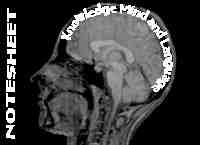The Chinese Room Argument
John Searle presents what is called the Chinese Room argument designed
to show that there is more to understanding than manipulating uninterpreted
symbols.
EXPOSITION
You are sat in a windowless room.Communication with the outside world
is achieved through two narrow letterbox slots. You sit at a desk on
which there is a large manual. By the side of the desk is a large box
containing sort of plastic shapes of a wide variety of different kinds.
From time to time a series of plastic shapes is pushed through the
in-slot. Your job is to take each sequence as it comes in and try and
find a match for it in the manual. The manual is so arranged that when
you find a picture of the sequence of shapes that has been pushed through
the in-slot, alongside it is printed another picture. This picture is
made up of the shapes that are to be found in the box by the desk.
What you have to do, once you have found a picture of the sequence
of shapes that came through the in-slot, is to assemble from the shapes
in your box the sequence the manual prints alongside it. You then push
this sequence of shapes you have just assembled out of the out slot.
You do this for many weeks.
You have been generating perfectly good Chinese sentences without
actually understanding a word. Therefore, says Searle, there is more
to understanding than manipulating uninterpreted symbols.
Computers, which are limited to manipulating uninterpreted
symbols, will never be able to understand.
THE ANALOGY BETWEEN WINDOWLESS ROOM AND A COMPUTER SPELLED OUT
A computer is just like the windowless room. A sequence of 'symbols' is pushed
in, manipulations are carried out involving those 'symbols' and the
other ones that are already in the room - in the box - and a string
of 'symbols' is output through the output slot.
"Understanding a language, or indeed having mental states at
all, involves more than just having a bunch of formal symbols. It involves
having an interpretation, or a meaning attached to those symbols."
Searle, Minds, Brains and Science, Cambridge, Mass, 1984, Harvard
University Press; White, p. 199.
RESPONSE TO CHINESE ROOM ARGUMENT
These two pointse:
1. The computer does not correspond to you sitting at the desk
arranging the symbols according to the rules in the manual.
The computer is the whole windowless room. Who is to
say the windowless room doesn't 'understand' the output??
2. If we are going to explain understanding it will be in terms that
don't refer to understanding. The cognitive scientist is claiming to
explain understanding I terms of the manipulation of representations.
It is no objection that his/her explanans does not refer to understanding.
|